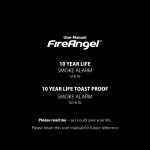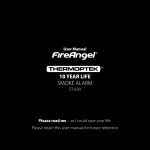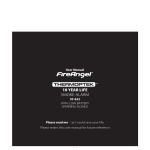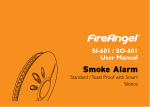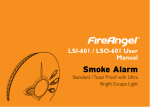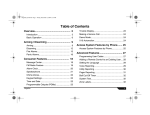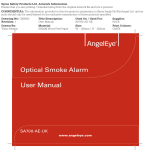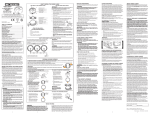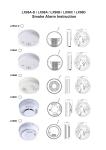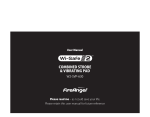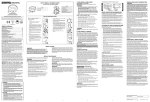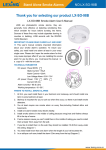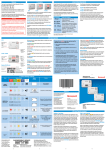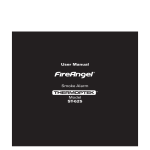Download User Manual
Transcript
User Manual EASY TO SILENCE SMOKE ALARM SI-601 TOAST PROOF SMOKE ALARM SO-601 Please read me – as I could save your life. Please retain this user manual for future reference CONTENTS 2 ALARM SMART SILENCE™ 12 2 ROUTINE MAINTENANCE 13 APPLICATION 3 14 POSITIONING 4 WHAT TO DO IN CASE OF FIRE IN YOUR HOME LIMITATIONS 6 REPAIR 15 TROUBLESHOOTING 16 DISPOSAL 19 HOW TO MAKE YOUR HOME SAFER 19 WARRANTY 21 RETURNS 22 PRODUCT RANGE 22 INTRODUCTION SENSOR TECHNOLOGY HOW TO INSTALL YOUR SMOKE ALARM 1 Preparation 2 Install mounting plate 3 Install 9V battery 4 Fit your smoke alarm 5 Test your smoke alarm OPERATION Normal Condition Low Battery Condition 7 9 BATTERY REPLACEMENT 10 ALARM TEST 11 Note: This User Manual is also available in large text and other formats. Please call 0800 141 2561 for further information INTRODUCTION SENSOR TECHNOLOGY This user manual covers the following two products, FireAngel SI-601 (Ionisation) Smoke Alarm and SO-601 Toast Proof (Optical) Smoke Alarm. There are two main types of smoke alarm. The SI-601 Standard Smoke Alarm uses an ionisation type sensor to detect the presence of smoke. Ionisation type smoke alarms are generally more effective at detecting fast, flaming fires which consume combustible materials rapidly and spread fire quickly. The SO-601 Toast Proof Smoke Alarm uses an optical (photoelectric) type sensor which is more effective at detecting slow burning fires, which can smoulder for hours before bursting into flames. Congratulations! You’ve made a wise investment in an innovative product and your personal safety. The FireAngel smoke alarms covered by this manual form part of a new generation of domestic life safety products from Sprue Safety Products Limited. The FireAngel range of products is constantly being improved and expanded. Please visit www.fireangel.co.uk to find out about the latest additions to our product range. IMPORTANT: This user manual contains important information regarding the operation of your FireAngel smoke alarm. Ensure you read this user manual fully before installing and operating the alarm. If you are installing this smoke alarm for use by others, you must leave this manual (or a copy of it) with the end user. 2 TOAST PROOF = Less sensitive to cooking fumes. (Optical alarms are less prone to nuisance alarms due to cooking fumes.) For maximum protection, use both types of smoke alarms on each level of your home APPLICATION WARNING: Your FireAngel smoke alarm can be installed into a new build property as additional protection to an existing smoke detection system only. It cannot be used as a substitute for a hard wired system as required in new build properties. In this type of property the building regulations require alarms to be interlinked. You can obtain further information from your local fire service or building control department at your local council offices. These sources generally provide advice on new builds or projects that require planning permission. Your smoke alarm typically meets the minimum requirements for family living units in existing buildings, as long as at least one unit is installed on each floor/level of your property. In order to achieve the earliest fire warning, we recommend that a smoke alarm is fitted in all rooms where the temperature is normally between 4° C (40° F) and 38° C (100° F). The type of smoke alarm used in each location should be appropriate to the environment. Check the section on ‘Positioning’ to ensure that the smoke alarm is to be correctly positioned for the particular dwelling into which it is intended to be installed. WARNING: The alarm positions shown overleaf are based on typical homes. Construction and layout of individual dwellings will vary, so this should be regarded only as a guide. Check with your local Fire and Rescue Service for further guidance. BEDROOM HALL DINING ROOM BEDROOM LOUNGE CELLAR EXISTING HOMES MINIMUM RECOMMENDATIONS RECOMMENDED FOR ADDITIONAL PROTECTION NOTE: Kitchens should be covered by a self contained heat detector. Multi-family or mixed occupant residence (Tenancy building, student accommodation) Your FireAngel smoke alarm can also be used in individual flats and bedsits, providing the same conditions are met as for a single-family residence. However, there must already be a primary fire detection system that meets regulatory requirements for common areas such as lobbies and hallways. 3 Institutions and Hotels This includes motels, hospitals, day care facilities, long-term health care facilities, boarding houses and dormitories. Your smoke alarm can be used in individual sleeping/resident rooms, providing the same conditions are met as for a single-family residence. However, there must already be a primary fire detection system that meets regulatory requirements for common areas such as lobbies and hallways. Use of this smoke alarm in common areas may not provide sufficient fire warning to residents or meet regulatory requirements. This smoke alarm is designed to operate as standalone smoke alarm. POSITIONING Ionisation type smoke alarms are generally more effective at detecting fast, flaming fires which consume combustable materials rapidly and spread fire quickly. Examples fast flaming fires = Ignited paper, flaming curtains and oil fires. Optical (Toast Proof) smoke alarms are less prone to false alarms from cooking fumes, are therefore suitable for locations near kitchens. However optical smoke alarms are more susceptible to nuisance alarms from steam and should not be located too close to bathrooms and showers. WARNING: This FireAngel smoke alarm will not communicate with other smoke alarms or fire alarm systems. It is not intended as a substitute for a complete alarm system. Examples of slow smouldering fires = cigarette on furniture and bedding, overheating electrical cables. Mobile Homes and Caravans This smoke alarm is suitable for use in mobile homes and caravans. It is recommended that your FireAngel smoke alarm is NOT to be fitted in the following locations: Commercial and Industrial Premises This smoke alarm is not intended for any non-residential, commercial or industrial application, nor for any other purpose than described above. • Bathrooms, shower-rooms, and other very damp or humid areas, where the moisture can cause unwanted alarms. • Kitchens. Kitchen areas should be protected with self-contained Heat Alarms, as the combustion particles from cooking in kitchens will result in unwanted alarms and permanent contamination of the smoke alarm’s sensor. • In areas where excessive dust or dirt could contaminate the sensing chamber, making 4 it over sensitive or impairing smoke entry. • In areas where the ambient temperature is not controlled and may regularly drift below 4° C (40° F) or above 38° C (100° F) e.g. unheated buildings, open attic spaces. • Very dirty, dusty or greasy areas. • In very draughty areas, such as close to ceiling fans or fresh air vents. Draughts can blow smoke away from the alarm. • In insect infested areas. Insects can clog openings to the sensing chamber, preventing smoke entry or causing unwanted alarms. • Within 30cm (12”) of a fluorescent light fitting which emits electrical ‘noise’ that can prevent correct alarm operation. • In wall positions that are more than 30cm (12”) away from the ceiling (see ‘How to install your smoke alarm’). • In ‘dead air’ spaces (see following diagram). • Within 30cm (12”) of light fittings or other ceiling based obstructions. 1 METRE (3 FEET) DEAD AIR SPACES BEST LOCATION (IN CENTRE OF CEILING) DEAD AIR SPACES 100MM (4 INCHES) 100MM (4 INCHES) 5 WHAT ARE THE LIMITATIONS OF MY SMOKE ALARM? batteries listed on page 10 should be used and must be changed immediately when the low battery signal is given or the unit will fail. Test weekly, read and follow all instructions or the unit will not operate properly. Your FireAngel smoke alarm is designed to alert you by sounding an alarm when it senses smoke, i.e. it can only sense smoke and alert you if smoke reaches it! If a fire develops in an area remote from the location of the smoke alarm, such as another room or another level, smoke may not reach the smoke alarm in sufficient time or quantity to sense and alert you to the danger. Your FireAngel smoke alarm will advise you of a low battery condition by emitting an audible ‘chirp’ every 40 seconds. When this occurs you must change the battery in the unit within 7 days to maintain correct operation. We recommend that as a minimum you install both ionisation and optical smoke alarms on every floor of your property. For comprehensive coverage a smoke alarm should also be fitted in every room. Your FireAngel smoke alarm will advise you of a low battery condition by emitting an audible ‘chirp’ every 40 seconds. When this occurs you must change the battery in the unit within 7 days to maintain correct operation. This smoke alarm cannot be used to provide primary fire detection in common areas used by different residents such as blocks of flats and hotels. The FireAngel smoke alarm may not alarm before a fire causes damage, injury or death, as the smoke may not reach the smoke alarm in time. Examples include smoking in bed and violent gas explosions. This smoke alarm may not respond in a reasonable time if it is not installed in the best position, or if furniture or other obstacles are located between the smoke alarm and the fire. IMPORTANT: Smoke alarms are designed to alert you with an audible alarm at a level specified by the European Standard EN 14604: 2005. Closed doors, walls and high ambient noise levels will reduce this level. Temporary or permanently impaired hearing may result in the alarm not being heard. Stereos, traffic and other loud sources may also prevent the alarm being heard. Heavy sleepers and residents under the influence of alcohol or drugs may also not hear or respond to the alarm. Test and check that you can hear the alarm in all circumstances. If in doubt install additional smoke alarms as required. WARNING: Your smoke alarm will not operate without a battery installed. Only WARNING: The Smoke alarm is not suitable for alerting hearing impaired 6 residents. We recommend that specially designed warning systems be installed that will alert hearing impaired residents. HOW TO INSTALL YOUR SMOKE ALARM The smoke alarm WARNING: accompanying this manual employs the latest technology and is independently tested as being compliant with all the relevant European Standards. However, as with any electronic product it may fail and may not sense all types of fire within sufficient time to alert you of the danger and provide adequate time for your escape. In order to maximise your level of safety always test your smoke alarm frequently to ensure it is in full working order. Your FireAngel smoke alarm is only suitable for use in domestic/ residential applications as covered in this manual. It is not suitable for commercial or industrial applications. It is designed to sense smoke and alert you. It will not sense carbon monoxide, flames, heat or gas. It will not prevent or extinguish fires. IMPORTANT: Make sure you have read and understood this manual before installing your smoke alarm. This FireAngel smoke alarm has a limited life of 10 years and should not be considered as a substitute for life or property insurance. Like all electronic equipment, it can wear out or fail. It should be tested weekly and replaced immediately in the event of failure, and replaced every 10 years regardless. 1 Preparation Attach the mounting plate to a ceiling or wall. Fixing slots If the alarm is to be mounted on a wall, ensure the mounting plate is aligned correctly. The mounting plate has an arrow moulded into the plastic. This indicates the orientation in which the mounting plate should be installed. This ensures that when the alarm is fitted the vents will be central and facing upwards. 7 Use the fixing slots on the mounting plate as a guide when marking the position of the drill holes. With an appropriately sized drill, drill the holes and insert the plastic fixing anchors supplied (if needed). 2 Install Mounting Plate Fit the mounting plate to the ceiling or wall using the screws provided. 3 Install 9V Battery IMPORTANT: Before installing your smoke alarm the battery must be removed from the alarm and the protective wrapper on the battery should be removed. The battery should then be refitted. The battery compartment has been designed to prevent the battery being inserted incorrectly. CAUTION: The horn is designed to be loud to wake you in an emergency. Avoid placing your ear close to the alarm when installing battery. Insert the battery that was provided with the alarm making sure that the positive and negative connections are in the correct position, see diagram. The red LED on the front should now flash once every 40 seconds to show the alarm is active. Ensure wrapper is removed 8 NOTE: On rare occasions the alarm may sound when the battery is first installed. If this happens, see Troubleshooting on page 16. The backing plate has a safety mechanism which prevents the alarm being installed without a battery. When the battery is inserted this safety mechanism is released meaning that the alarm can be attached to the backing plate. 4 Fit Your FireAngel Smoke Alarm The alarm will only lock into place in one particular position. Position the smoke alarm over the mounting plate lining up the central vent on the front of the alarm with the ‘X’ moulded into the plastic on the mounting plate and turn clockwise. After one quarter turn you should feel the alarm click into place. OPERATION Normal condition The red LED on the front should flash once every 40 seconds to show the alarm is active. Low Battery Condition IMPORTANT: Your smoke alarm requires a battery with a sufficient capacity of power to operate correctly, this must also be correctly installed. Should your FireAngel smoke alarm enter a low battery condition, the unit will emit an audible ‘chirp’ once every 40 seconds. When this occurs you must replace the battery immediately. Your FireAngel smoke alarm will continue to warn of this low battery condition for at least 7 days, however, failure to change the battery after this time would mean your smoke alarm has insufficient power to alert you in a real fire situation. 5 Test Your FireAngel Smoke Alarm See ‘Alarm Test’ on page 11. 9 BATTERY REPLACEMENT the correct position. If unsure see diagram in “3. Install 9v battery” section (Page 8). IMPORTANT: Only the following batteries can be used for replacement. Use of a battery other than those recommended below may have a detrimental effect on the detector’s operation. Use of a lithium (longlife) battery could provide power for 10 years under normal operating conditions, meaning there is no need for an annual battery change. Carbon-Zinc type: Eveready Energizer 1222; Gold Peak 1604S (UL). Alkaline Type Energizer 522; Duracell MN1604; Duracell 9V Ultra; Energizer 9V Ultra+; Gold Peak 1604A. Lithium (long life) type Ultralife U9VL. a Remove the alarm from its mounting plate by turning anti-clockwise b Remove the existing battery and replace with a new battery, from the list on previous page, making sure that the positive and negative connections are in 10 c Replace the alarm on its mounting plate, lining up the large central vent on the front of the alarm, with the ‘X’ that is moulded into the plastic on the mounting plate (if unsure see page 8). Ensure the unit is securely fitted. d Test your alarm as explained in the next section ‘Alarm Test’. ALARM TEST c The red LED on your alarm will flash rapidly during the audible signal. NOTE: The test button accurately tests the alarm’s smoke sensing circuit, there is no need to test your alarm with smoke. If your smoke alarm fails to give an audible test signal, please refer immediately to the trouble shooting guide at the end of this manual. a Press the test button in the centre and release. WARNING: Test your smoke alarm at least once per week. b The unit will emit a loud (85dB at 3 meters) alarm for around 5 seconds and stop automatically. 11 ALARM SMART SILENCE™ DANGER: If your FireAngel smoke alarm emits the full alarm signal and you are not testing the unit, the smoke alarm is warning you of a potentially dangerous situation that requires your immediate attention. Only use the alarm silence function after making sure that there is no ongoing fire emergency situation. Do not block the vents on the alarm or disable the smoke alarm in any way, as this will remove your protection. In the event of a known false alarm such as cooking fumes your smoke alarm can be silenced in the following way. Your smoke alarm features “Smart Silence™” technology. Smoke alarms can sometimes react to cooking fumes or other non emergency situations. Should your alarm sound the central test button can be used to temporarily silence the alarm. Your alarm will automatically return to full sensitivity within 10 minutes. NOTE: If the level of smoke reaching the alarm is very high the alarm silence will be overridden and the alarm will continue to sound. 12 a Press and release the silence button, the alarm sound will shortly stop. b Your alarm will silence and enter into a reduced sensitivity reset cycle for approximately 10 minutes. ROUTINE MAINTENANCE c During the reduced sensitivity reset cycle, the red LED on your alarm will flash more rapidly than normal, approximately once every 10 seconds. Your FireAngel smoke alarm has been designed to be as maintenance-free as possible, however in addition to battery maintenance, there are several things you must do to keep it working properly. CAUTION: Your FireAngel smoke alarm is a sealed electrical device and no attempt should be made to open the case. Attempting to open the case will invalidate your Warranty. Testing Test your smoke alarm once every week see section ‘Alarm Test’ on page 11. Any test failures should be reported to the FireAngel Technical Support Team on page 18. d Your alarm will automatically return to full sensitivity on completion of the reset cycle and the red LED will revert to flashing once every 40 seconds. Cleaning As a minimum your smoke alarm should be cleaned once every 3 months using your vacuum cleaner fitted with the soft brush attachment. DANGER: Never ignore any alarm. Ignoring the alarm may result in injury or death. If your smoke alarm activates and alarms and you are not absolutely certain of the source of the smoke, get everyone out of the house immediately. 13 WARNING: Your FireAngel smoke alarm may false alarm when it is being cleaned using a vacuum cleaner. WHAT TO DO IN CASE OF A FIRE IN YOUR HOME IMPORTANT: Do not use solvents or cleaners on your FireAngel smoke alarm, as they may cause damage to the sensor or circuitry. The unit can be wiped with a slightly damp cloth. • If you have made a family escape plan and practiced it with your family, you have increased their chances of escaping safely. Go over the following rules with your children each time you have fire drills. This will help everyone remember them in case of a real emergency. • Don’t panic, stay calm. Your safe escape may depend on thinking clearly and remembering what you have practiced. • Notify every member in the residence of the fire. • Get out of the house as quickly as possible. Follow a planned escape route. Do not stop to collect anything or to get dressed. • Feel the doors to see if they are hot. If they are hot, do not open them – use an alternative escape route. • Stay close to the floor. Smoke and hot gases rise. • Cover your nose and mouth with a cloth (wet if possible). Take short, shallow breaths. • Keep doors and windows closed. Open them only if you have to in order to escape. • Meet at your planned meeting place after leaving the house. Carry out a headcount. • Call the Fire and Rescue Sevice on 999 as soon as possible from outside your house. If possible use a neighbours phone or call CAUTION: Do not Paint the smoke alarm as this may block the openings and prevent smoke from entering the sensor. 14 box rather than a mobile phone (as the location can be traced from the number if the line is lost, or the battery runs out for example). • Give the address and your name. • Never go back inside the building until a member of the fire service has told you it is safe to do so. Contact your local Fire and Rescue Service. They will give you more ideas about how to make your home safer from fires and how to plan your family’s escape. REPAIR DO NOT attempt to repair your FireAngel smoke alarm doing so will invalidate your warranty. If your smoke alarm is not operating properly, see the next section ‘Troubleshooting’. If you cannot solve the problem, please call the Technical Support Line. If your FireAngel smoke alarm is no longer under warranty, replace immediately with a comparable FireAngel brand smoke alarm. 15 TROUBLESHOOTING 16 Problem Solution Your FireAngel smoke alarm goes into alarm when first connecting the battery • SI-601 Only: Ionisation alarms can be affected by high levels of static. It may be that the false alarm has been caused by this when handling the alarm. Remove static that may have been transferred to the alarm by wiping the front cover with a slightly damp cloth. Your FireAngel smoke alarm does not test when installed • Make sure you have removed the wrapper from the battery before reconnecting. Your FireAngel smoke alarm chirps intermittently • Check the location of your smoke alarm (see ‘Application & Positioning’). • Check that your smoke alarm is definitely the source of chirping; make sure the noise isn’t coming from another alarm (smoke/carbon monoxide/gas/burglar alarm) by process of elimination. • Replace battery. If the battery has been recently fitted and the chirping continues then contact technical support. Your FireAngel smoke alarm activates when no smoke is visible • Check the location of your smoke alarm (see the section on ‘Positioning’). • Clean the smoke alarm (see the section on ‘Routine Maintenance’). • For SI-601 smoke alarm only remove build-up of static electricity by wiping your FireAngel smoke alarm with a slightly damp cloth. • Check battery is correctly fitted, if the battery has been in service for more than 12 months replace battery regardless. You experience frequent unwanted alarms • Check the location of your FireAngel smoke alarm (see the section on ‘Positioning’). • Clean the smoke alarm (see the section on ‘Routine Maintenance’). • SI-601 Only: Remove buildup of static electricity by wiping your smoke alarm with a slightly damp cloth. • If the frequent unwanted alarms continue contact technical support for advice. Your FireAngel smoke alarm does not sound during testing • Make sure you push the test button firmly • If the unit has been silenced and is in low sensitivity mode it may not test. Wait 15 minutes then try again. • Replace battery. If the battery has been recently fitted and the alarm still fails to self test then contact technical support. 17 If the alarm fails to operate correctly, the advice of the manufacturer should be sought 18 If you have any questions about the operation of your alarm, please contact the FireAngel Technical Support Team between 9am - 5pm Monday – Friday. Telephone: 0800 141 2561 (1-800 523171 in EIRE) or e-mail: [email protected] You can also visit the support section of our website www.fireangel.co.uk DISPOSAL Waste electrical products should not be disposed of with regular household waste. HOW TO MAKE YOUR HOME SAFER Installing smoke alarms is only one step in protecting your family from fires. You must also take steps to reduce the chances of fires starting in your home. If a fire does start, you must increase your chances of escaping. Please recycle where facilities exist. Check with your local authority, retailer or the FireAngel Technical Support Line (see page 18 for contact details) for recycling/disposal advice as regional variations apply. To have a good fire safety program you must: The batteries should be removed before disposal of the detector. Both the batteries and the detector should be disposed of in line with current regulations. 1 Install smoke alarms properly. Carefully follow ALL the instructions in this manual. Keep your smoke alarms clean, and test them every week. WARNING: DO NOT ATTEMPT TO OPEN. WARNING: DO NOT BURN. SMOKE ALARMS THAT DO NOT WORK WILL NOT ALERT YOU. 2 Replace your smoke alarms immediately if they are not working properly. 3 Follow fire safety rules, and prevent hazardous situations: • Use smoking materials properly. Never smoke in bed. • Keep matches and cigarette lighters away from children. • Store flammable materials in proper containers. Never use them near an open flame or sparks. • Keep electrical appliances and wiring in good condition. Do not overload electrical circuits. • Keep cookers, fireplaces, chimneys, and barbecue grills grease free. Make sure 19 they are properly installed, away from any combustible materials. • Keep portable heaters and open flames such as candles away from combustible materials. • Do not allow rubbish to accumulate inside your home as this provides sources for combustion. • Keep a supply of extra batteries on hand for your battery powered Smoke Alarms. 4 Develop a family escape plan and practice it with everyone in the household, including small children if you have them. • Draw a floor plan of your home, and find two ways to exit from each room. There should be one way to get out of each bedroom without opening the door, and alternate means of escape from an upper floor in the event of the stairs being blocked (such as a fire escape). • Make sure everyone recognises the smoke alarm signal and knows how to react to it. • If there are small children to consider it is important to explain to them what the smoke alarm signal means. Teach them that they must be prepared to leave the home by themselves if necessary. Show them how to check to see if doors are hot before opening them. Show them how to stay close to the floor and crawl if necessary. Show them how to use an alternative exit if the door is hot and should not be opened. 20 • Decide on a meeting place a safe distance from your house. Again, if you have them, make sure that all your children understand that they should go and wait for you there if there is a fire. • Hold fire drills at least every 6 months to make sure that everyone, including small children, know what to do to escape safely. • Know where to go to call the Fire and Rescue Service from outside your home. Contact your local Fire and Rescue Sevice. They will give you more ideas about how to make your home safer from fires and how to plan your family’s escape. WARRANTY Sprue Safety Products Ltd warrants to the original purchaser that its enclosed smoke alarm be free from defects in materials and workmanship under normal residential use and service for a period of 5 (five) years from the date of purchase in the case of the SI-601 and SO-601 products. Provided it is returned with postage prepaid and proof of purchase date, Sprue Safety Products Ltd hereby warrants that during the 5 (five) year period commencing from the date of purchase in the case of the SI-601 and SO-601 Sprue Safety Products Ltd, at its discretion, agrees to replace the unit free of charge. The warranty on any replacement SI or SO range of alarm, will last for the remainder of the period of the original warranty in respect of the alarm originally purchased – that is from the date of original purchase and not from the date of receipt of the replacement product. Sprue Safety Products Ltd reserves the right to offer an alternative product similar to that being replaced if the original model is no longer available or in stock. This warranty applies to the original retail purchaser from the date of original retail purchase and is not transferable. Proof of purchase is required. Safety Products Ltd’s control, such as Acts of God (fire, severe weather etc.). It does not apply to retail stores, service centres or any distributors or agents. Sprue Safety Products Ltd will not recognise any changes to this warranty by third parties. Sprue Safety Products Ltd shall not be liable for any incidental or consequential damages caused by the breach of any expressed or implied warranty. Except to the extent prohibited by applicable law, any implied warranty of merchantability or fitness for a particular purpose is limited in duration for 5(five) years for the SI-601 and SO-601 products. This warranty does not cover the battery, which is considered a user replaceable part. This warranty does not affect your statutory rights. This warranty does not cover damage resulting from accident, misuse, disassembly, abuse or lack of reasonable care of the product, or applications not in accordance with the user manual. It does not cover events and conditions outside of Sprue 21 RETURNS PRODUCT RANGE We recommend that you contact the FireAngel Technical Support Line in the first instance on 0800 141 2561, text phone users dial 18001 0800 141 2561 or callers from EIRE dial 1-800 523171. As we may be able to remedy the problem quickly over the phone (this is to prevent unnecessary returns that take a longer time to process). Alternatively e-mail: [email protected] Sprue Safety Products Ltd. manufacture an extensive range of home safety products including smoke alarms, carbon monoxide alarms, fire extinguishers and remote sounding devices. For more details visit www.sprue.com If there is a fault that we are unable to resolve then our technical support team member will issue you with a returns authority number so that your product can be returned for testing. To return your FireAngel smoke alarm under warranty, send it suitably packed and with the battery disconnected with postage prepaid; a note indicating the returns authority number and describing the nature of the difficulty, with proof of purchase to: 22 Sprue Safety Products Limited Vanguard Centre Sir William Lyons Road Coventry CV4 7EZ UK NOTES 23 NOTES 24 Technical Support Line 0800 141 2561 UK Textphone users dial 18001 0800 141 2561 EIRE dial 1-800 523171 Email [email protected] SI-601 10 0832-CPD-1332 Smoke alarm devices EN 14604:2005 Web www.fireangel.co.uk SO-601 10 0832-CPD-1335 Smoke alarm devices EN 14604:2005 SI-601 A Sprue Safety Products Brand Sprue Safety Products Ltd. Vanguard Centre, Sir William Lyons Road, Coventry CV4 7EZ UK SI-601 / SO-601 GN0382R3 Certificate No.651d/01 SO-601 Certificate No.651d/04





























